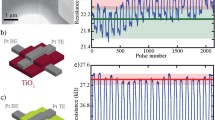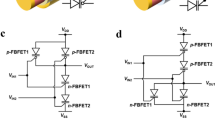Abstract
The physically separated memory and logic units in traditional von Neumann computers place essential limits on the performance and cause increased energy consumption, and hence in-memory computing is required to overcome this bottleneck. Here, a new bipolar memristor based in-memory logic approach is proposed, which is capable of achieving all 16 possible Boolean logic functions in a single device in less than 3 steps. This approach does not require initialization and can facilitate logic cascading, and the calculation taking place in-situ is showcased by 1-bit full adder and 2-bit multiplier with improved efficiency, thus showing a great prospect in future in-memory computing architecture.
Similar content being viewed by others
References
Waldrop M M. The chips are down for Moore’s law. Nature, 2016, 530: 144–147
Ventra M D, Pershin Y V. The parallel approach. Nat Phys, 2013, 9: 200–202
Cassinerio M, Ciocchini N, Ielmini D. Logic computation in phase change materials by threshold and memory switching. Adv Mater, 2013, 25: 5975–5980
Merolla P A, Arthur J V, Alvarez-Icaza R, et al. A million spiking-neuron integrated circuit with a scalable communication network and interface. Science, 2014, 345: 668–673
Prezioso M, Merrikh-Bayat F, Hoskins B D, et al. Training and operation of an integrated neuromorphic network based on metal-oxide memristors. Nature, 2015, 521: 61–64
Li S C, Xu C, Zou Q S, et al. Pinatubo: a processing-in-memory architecture for bulk bitwise operations in emerging non-volatile memories. In: Proceedings of the 53rd Annual Design Automation Conference, Austin Texas, 2016
Borghetti J, Snider G S, Kuekes P J, et al. ‘Memristive’ switches enable ‘stateful’ logic operations via material implication. Nature, 2010, 464: 873–876
Linn E, Rosezin R, Tappertzhofen S, et al. Beyond von Neumann-logic operations in passive crossbar arrays alongside memory operations. Nanotechnology, 2012, 23: 305205
Yang Y C, Yin M H, Yu Z Z, et al. Multifunctional nanoionic devices enabling simultaneous heterosynaptic plasticity and efficient in-memory Boolean logic. Adv Electron Mater, 2017, 3: 1700032
Xu L Y, Yuan R, Zhu Z H, et al. Memristor-based efficient in-memory logic for cryptologic and arithmetic applications. Adv Mater Technol, 2019, 4: 1900212
Goswami S, Matula A J, Rath S P, et al. Robust resistive memory devices using solution-processable metal-coordinated azo aromatics. Nat Mater, 2017, 16: 1216–1224
Wong H S P, Salahuddin S. Memory leads the way to better computing. Nat Nanotech, 2015, 10: 191–194
Hwang C S. Prospective of semiconductor memory devices: from memory system to materials. Adv Electron Mater, 2015, 1: 1400056
Ma W, Zidan M A, Lu W D. Neuromorphic computing with memristive devices. Sci China Inf Sci, 2018, 61: 060422
Yang Y C, Huang R. Probing memristive switching in nanoionic devices. Nat Electron, 2018, 1: 274–287
Yang J J, Pickett M D, Li X, et al. Memristive switching mechanism for metal/oxide/metal nanodevices. Nat Nanotech, 2008, 3: 429–433
Kim K M, Jeong D S, Hwang C S, et al. Nanofilamentary resistive switching in binary oxide system; a review on the present status and outlook. Nanotechnology, 2011, 22: 254002
Choi B J, Jeong D S, Kim S K, et al. Resistive switching mechanism of TiO2 thin films grown by atomic-layer deposition. J Appl Phys, 2005, 98: 033715
Ielmini D, Wong H S P. In-memory computing with resistive switching devices. Nat Electron, 2018, 1: 333–343
Vourkas I, Sirakoulis G C. Emerging memristor-based logic circuit design approaches: a review. IEEE Circ Syst Mag, 2016, 16: 15–30
Li H T, Gao B, Chen Z W, et al. A learnable parallel processing architecture towards unity of memory and computing. Sci Rep, 2015, 5: 13330
Serb A, Khiat A, Prodromakis T. Seamlessly fused digital-analogue reconfigurable computing using memristors. Nat Commun, 2018, 9: 2170
You T G, Shuai Y, Luo W B, et al. Exploiting memristive BiFeO3 bilayer structures for compact sequential logics. Adv Funct Mater, 2014, 24: 3357–3365
Breuer T, Siemon A, Linn E, et al. A HfO2-based complementary switching crossbar adder. Adv Electron Mater, 2015, 1: 1500138
Siemon A, Breuer T, Aslam N, et al. Realization of Boolean logic functionality using redox-based memristive devices. Adv Funct Mater, 2015, 25: 6414–6423
Gao S, Zeng F, Wang M J, et al. Implementation of complete Boolean logic functions in single complementary resistive switch. Sci Rep, 2015, 5: 15467
Huang P, Kang J F, Zhao Y D, et al. Reconfigurable nonvolatile logic operations in resistance switching crossbar array for large-scale circuits. Adv Mater, 2016, 28: 9758–9764
Chen B, Cai F X, Zhou J T, et al. Efficient in-memory computing architecture based on crossbar arrays. In: Proceedings of IEEE International Electron Devices Meeting (IEDM), Washington, 2015
Kvatinsky S, Belousov D, Liman S, et al. MAGIC-memristor-aided logic. IEEE Trans Circ Syst II, 2014, 61: 895–899
Shen W S, Huang P, Fan M Q, et al. Stateful logic operations in one-transistor-one- resistor resistive random access memory array. IEEE Electron Device Lett, 2019, 40: 1538–1541
Liu G Z, Zheng L J, Wang G Y, et al. A carry lookahead adder based on hybrid CMOS-memristor logic circuit. IEEE Access, 2019, 7: 43691–43696
Xu N, Park T G, Kim H J, et al. A stateful logic family based on a new logic primitive circuit composed of two antiparallel bipolar memristors. Adv Intell Syst, 2020, 2: 1900082
Yang H, Duan S K, Dong Z K, et al. A memristor-CMOS-based general-logic circuit and its applications (in Chinese). Sci Sin Inform, 2020, 50: 289–302
Wald N, Kvatinsky S. Understanding the influence of device, circuit and environmental variations on real processing in memristive memory using memristor aided logic. MicroElectron J, 2019, 86: 22–33
Cheng L, Zhang M Y, Li Y, et al. Reprogrammable logic in memristive crossbar for in-memory computing. J Phys D-Appl Phys, 2017, 50: 505102
Kvatinsky S, Satat G, Wald N, et al. Memristor-based material implication (IMPLY) logic: design principles and methodologies. IEEE Trans VLSI Syst, 2014, 22: 2054–2066
Adam G C, Hoskins B D, Prezioso M, et al. Optimized stateful material implication logic for three-dimensional data manipulation. Nano Res, 2016, 9: 3914–3923
Chen W H, Lin W J, Lai L Y, et al. A 16 Mb dual-mode ReRAM macro with sub-14 ns computing-in-memory and memory functions enabled by self-write termination scheme. In: Proceedings of IEEE International Electron Devices Meeting (IEDM), San Francisco, 2017
Acknowledgements
This work was supported by National Key R&D Program of China (Grant No. 2017YFA0207600), National Natural Science Foundation of China (Grant Nos. 61925401, 61674006, 61927901, 61421005), and the 111 Project (Grant No. B18001). Yuchao YANG acknowledges the support from Beijing Academy of Artificial Intelligence (BAAI) and the Tencent Foundation through the Xplorer Prize.
Author information
Authors and Affiliations
Corresponding authors
Rights and permissions
About this article
Cite this article
Yuan, R., Ma, M., Xu, L. et al. Efficient 16 Boolean logic and arithmetic based on bipolar oxide memristors. Sci. China Inf. Sci. 63, 202401 (2020). https://doi.org/10.1007/s11432-020-2866-0
Received:
Revised:
Accepted:
Published:
DOI: https://doi.org/10.1007/s11432-020-2866-0




